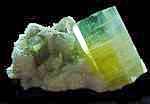

`
 |
 |
| Mining Operations at Mount Mica & Orchard Pit Mines, Oxford County, Maine. | |
Coromoto Minerals Mining
Operations at Mount Mica,
April-May-June 2007
Page 3
|
After the visit by the Maine Pegmatite Haulage was becoming an increasingly difficult and time consuming task as the amount of rock to be removed escalated. Our JD skid steer was no longer adequate for the task. Many trips were required to travel out the muck from a single blast. In addition, as the JD would push against the muck pile, the engine would bog down and emit heavy noxious fumes generated by the incomplete fuel combustion in the engine. This was true even with the use of Mine-X catalytic converter on the skid steer. A re-think was required. To address the air quality issue, we again had Hodgdeon Well Drilling out to drill several 8" diameter holes in the ceiling of the Pink Room. With the use of 2 high speed fans drawing out the air, the air quality issue was solved. Blast fumes now also cleared much more rapidly. We had considered buying an LHD (Load Haul and Dump) machine. These are expensive and any that we could afford would be quite beyond their prime. I was afraid they would come with a heavy dose of maintenance issues. Since we are only a two man crew, there is no excess of manhours to devote to maintaining aged equipment even if we knew what we were doing. The solution we took was to buy a new Yanmar C30R all terrain carrier. This proved to be a good choice. Using our Kubota excavator and the Yanmar, yardage on each trip went from 1 to over 3. The Yanmar soon develop other roles. We used it extensively to haul equipment and as a drill platform. Now we no longer had to pile up muck in order to drill the higher holes as we did an advance. This was a big time saver.
With our armamentarium
We mined out the balance of the bench that can be seen in the image above right. The mineralization continued unabated, but accessing this area, as we were doing, was difficult and would result in the loss of pocket material if it slipped into the water. Our best bet would be to return to the deepest part of the mine and drive a new drift as deep as possible. At minimum, such an effort would be a couple of seasons work. As Frank Perham, the gifted observer of the silver lining, pointed out, I would not live long enough to dig up Mount Mica. That's not all bad...I guess. At this point, we decided to turn north and then west to explore the area just below the water filled upper pit and finish the pocket that the Workshop people had worked.
|